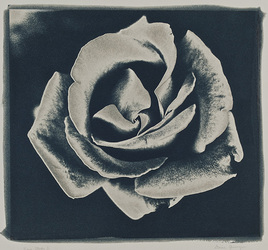Cyanotypes
Cyanotype--meaning blue and print--is an historic photographic process first developed in 1842 by Sir John Herschel just a few years after the invention of photography. It was the first permanent process and the earliest woman photographer, Anna Atkins, was the first person to print and publish a photographically illustrated book, British Algae in 1843.
I print many of my statuary images using the cyanotype or blueprint process and then tone the prints for color variation. In my work I use fine watercolor paper sensitized with cyanotype chemistry--equal solutions of ferric ammonium citrate and potassium ferricyanide--and then contact-print the enlarged negative to the sensitized paper using sunlight, the strongest source of actinic light. This reduces a portion of the ferric salt to the ferrous state, and a portion of the ferricyanide to ferrocyanide, resulting in the formation of a blue image consisting of ferrous ferrocyanide.
After exposure, the cyanotype print is developed by washing in water to remove the soluble, unreduced salts, leaving insoluble ferrous ferrocyanide behind. The blue image deepens upon drying. To achieve various colors--sometimes a purple black--the print is later bleached and then immersed in a solution of tannic acid, a process which tones the final print.
I also print my cyanotypes using photograms. A photogram is a photographic image obtained without using a camera. It is produced simply by the action of light striking a light-sensitive surface. Objects are arranged directly onto the light sensitive paper.
The cyanotype process is inherently unpredictable. Sunlight exposure time varies greatly from month to month, season to season, but the result can be a joy.
Cyanotype--meaning blue and print--is an historic photographic process first developed in 1842 by Sir John Herschel just a few years after the invention of photography. It was the first permanent process and the earliest woman photographer, Anna Atkins, was the first person to print and publish a photographically illustrated book, British Algae in 1843.
I print many of my statuary images using the cyanotype or blueprint process and then tone the prints for color variation. In my work I use fine watercolor paper sensitized with cyanotype chemistry--equal solutions of ferric ammonium citrate and potassium ferricyanide--and then contact-print the enlarged negative to the sensitized paper using sunlight, the strongest source of actinic light. This reduces a portion of the ferric salt to the ferrous state, and a portion of the ferricyanide to ferrocyanide, resulting in the formation of a blue image consisting of ferrous ferrocyanide.
After exposure, the cyanotype print is developed by washing in water to remove the soluble, unreduced salts, leaving insoluble ferrous ferrocyanide behind. The blue image deepens upon drying. To achieve various colors--sometimes a purple black--the print is later bleached and then immersed in a solution of tannic acid, a process which tones the final print.
I also print my cyanotypes using photograms. A photogram is a photographic image obtained without using a camera. It is produced simply by the action of light striking a light-sensitive surface. Objects are arranged directly onto the light sensitive paper.
The cyanotype process is inherently unpredictable. Sunlight exposure time varies greatly from month to month, season to season, but the result can be a joy.









